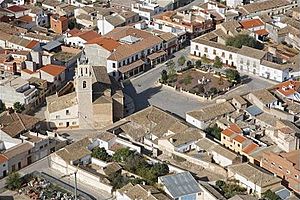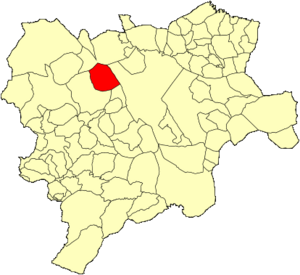Barrax facts for kids
Quick facts for kids
Barrax
|
|||
|---|---|---|---|
 |
|||
|
|||

Location of Barrax
|
|||
| Municipality | Spain | ||
| Autonomous community |
Castilla-La Mancha | ||
| Province | Albacete | ||
| Mancomunidad | La Mancha-Centro Júcar | ||
| Area | |||
| • Total | 189.86 km2 (73.31 sq mi) | ||
| Elevation | 731 m (2,398 ft) | ||
| Population
(2018)
|
|||
| • Total | 1,864 | ||
| • Density | 9.8178/km2 (25.428/sq mi) | ||
| Demonym(s) | Barrajenses Barrajeño,-ña |
||
| Area code(s) | 967 | ||
| Province code | 02 | ||
| Municipal code | 015 | ||
| Distance from Albacete | 29 km (18 mi) | ||
Barrax is a small town in Spain. It's part of the Albacete province. This province is in the region called Castile-La Mancha. Barrax sits on a high flat area. It's near the Alcaraz mountains. It's mostly a farming town. Big fields of grain surround it.
History of Barrax
Barrax has a long history. People say it started as an old inn. This inn was called "Barraj sale." It was a stop for travelers on a main road. This road connected Andalusia with central Spain. Barrax was part of Alcaraz back then.
On September 20, 1564, Barrax became its own town. King Philip II of Spain made it a "Villa." The oldest official records are from 1601. These are church records.
Getting water was important for Barrax. The first known water source was a well. It was across from San Roque church. There were also two other wells. These were on the edge of town. Later, water came from El Cornudillo farm. This farm was near Lezuza. The water was stored near the Windmill.
In the old days, people waited in lines. They waited with pitchers for water. This happened in the square. A new well, "La Morra," opened in 1966. On October 24, 1966, water reached the main square.
Famous Buildings
Immaculate Conception Church
This church is in the main square. It's across from the City Hall. It was finished in 1766. This was during the time of King Carlos III. The church has a neoclassical style. It was badly damaged during the Civil War. In 1945, part of it collapsed. This led to repairs and changes to the tower. The church was restored again in 2001.
San Roque Chapel
This chapel is inside the village. It was rebuilt in 1884. In 2006, the chapel was restored. During these works, old frescoes were found. These paintings date back to the early 1500s.
New City Hall
The new City Hall is on the land of an old house. This house was called Lodares. Its porch was restored in 2006. Shields from northern Spain were found there. These shields are from the 1400s. The porch itself is from the 1500s.
Christ of Forgiveness Chapel
This chapel was rebuilt in 1997. A priest named Don Felix Ibarguchi redesigned it. Inside, there is a modern Stations of the Cross. This was also designed by the priest. The chapel holds a statue of Christ of Forgiveness. This statue is a copy of the original. The first one was burned during the Civil War.
Barrax Windmill
The Windmill is a symbol of Barrax. It stands on top of the town. In 2006, a large walking area opened nearby. It has parks for kids. There are also fitness areas and picnic tables. This is for everyone to enjoy. The windmill is very old. It has been restored many times. Don Benjamín Palencia did the first restoration.
Interesting Places
Finca Las Tiesas
This is a special farm. Scientists use it for studies. The European Space Agency has funded projects here. They like this place because it's flat. The skies are usually clear. They grow crops like alfalfa and barley. They can control how these crops grow. This makes Barrax important for studying Earth from space. Scientists who observe Earth know Barrax well.
Hill of the Three Bishops
This hill is 740 meters high. It's called "Hill of the three bishops." This is because it was a meeting point. It was where three bishoprics met. These were Toledo, Cuenca, and Cartagena. This changed in 1950. That's when the Diocese of Albacete was created. Barrax joined this new diocese in 1996.
Santa Quiteria Hill
A festival is held here. It honors Santa Quiteria. This hill marks the start of the La Mancha landscape.
The Fourth Philemon
This place is in a valley. It's just past Santa Quiteria hill. In the middle of this valley is "The Fourth Philemon." It is an ancient village.
Arab Cistern
An old Arab cistern is located near Barrax. It dates back to the 1400s. It's about 300 meters towards Villarrobledo.
Festivals and Celebrations
Santa Quiteria Pilgrimage
This pilgrimage happens on May 22. People walk in a procession. They carry an image of Santa Quiteria. They go to her shrine on the hill. This tradition started with a picnic. Friends of a priest had a snack. It was for his mother's birthday. They had it on Santa Quiteria hill. This became a yearly event.
San Roque Celebrations
These celebrations are from August 13 to 17. They are famous for the "bull of fire." On August 15, they honor the Virgen de Agosto. August 16 is for San Roque. August 17 is for San Roquillo.
The "fire Toro" is a fun tradition. Men wear mobile structures. These structures have horn shapes. They are filled with fireworks. The men run through the streets. This creates exciting chases for people watching.
See also
 In Spanish: Barrax para niños
In Spanish: Barrax para niños



